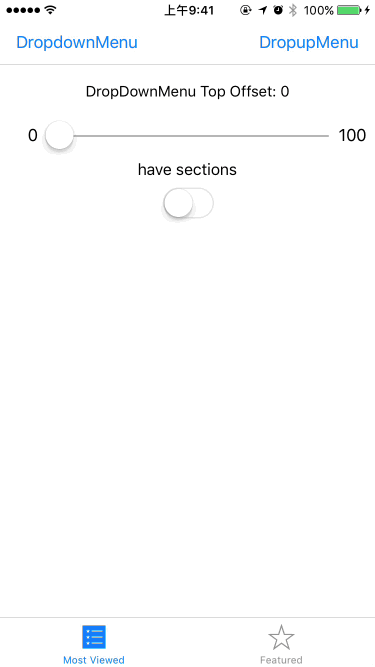DropdownMenu is a dropdown menu for navigationController in Swift, It can be associated in any place if have a navigationController
- Dropdown Menu
- Dropup Menu
- Only text cell
- Image and text cell
- Highlight cell
- Seleted cell
- Detail accessory cell
- iOS 8.0
- Xcode 7.3+
- If you need help, please add issues. or send email to zhangxiaolian1991@gmail.com
**Embedded frameworks require a minimum deployment target of iOS 8
CocoaPods is a dependency manager for Cocoa projects. You can install it with the following command:
$ gem install cocoapodsTo integrate DropdownMenu into your Xcode project using CocoaPods, specify it in your Podfile:
source 'https://github.com/CocoaPods/Specs.git'
platform :ios, '8.0'
use_frameworks!
target '<Your Target Name>' do
pod 'TBDropdownMenu'
endThen, run the following command:
$ pod installCarthage is a decentralized dependency manager that builds your dependencies and provides you with binary frameworks.
You can install Carthage with Homebrew using the following command:
$ brew update
$ brew install carthageTo integrate DropdownMenu into your Xcode project using Carthage, specify it in your Cartfile:
github "teambition/DropdownMenu"
Run carthage update to build the framework
At last, you need to set up your Xcode project manually to add the DropdownMenu framework.
On your application targets’ “General” settings tab, in the “Linked Frameworks and Libraries” section, drag and drop each framework you want to use from the Carthage/Build folder on disk.
On your application targets’ “Build Phases” settings tab, click the “+” icon and choose “New Run Script Phase”. Create a Run Script with the following content:
/usr/local/bin/carthage copy-frameworks
and add the paths to the frameworks you want to use under “Input Files”:
$(SRCROOT)/Carthage/Build/iOS/DropdownMenu.framework
For more information about how to use Carthage, please see its project page
Cocoapods:
import TBDropdownMenuCarthage:
import DropdownMenufunc showMenu(sender: UIBarButtonItem) {
let item1 = DropdownItem(title: "NO Image")
let item2 = DropdownItem(image: UIImage(named: "file")!, title: "File")
let item3 = DropdownItem(image: UIImage(named: "post")!, title: "Post", style: .Highlight)
let item4 = DropdownItem(image: UIImage(named: "post")!, title: "Event", style: .Highlight, accessoryImage: UIImage(named: "accessory")!)
let items = [item1, item2, item3, item4]
let menuView = DropdownMenu(navigationController: navigationController!, items: items, selectedRow: selectedRow)
menuView.delegate = self
menuView.showMenu()
} @IBAction func showMenu(_ sender: UIBarButtonItem) {
let item1 = DropdownItem(title: "NO Image")
let item2 = DropdownItem(image: UIImage(named: "file")!, title: "File")
let item3 = DropdownItem(image: UIImage(named: "post")!, title: "Post", style: .highlight)
let item4 = DropdownItem(image: UIImage(named: "post")!, title: "Event", style: .highlight, accessoryImage: UIImage(named: "accessory")!)
let section0 = DropdownSection(sectionIdentifier: "Teambition", items: [item1, item2])
let section1 = DropdownSection(sectionIdentifier: "Space", items: [item3, item4])
let menuView = DropdownMenu(navigationController: navigationController!, sections: [section0, section1], selectedIndexPath: selectedIndexPath)
menuView?.delegate = self
menuView?.showMenu()
}extension ViewController: DropdownMenuDelegate {
func dropdownMenu(dropdownMenu: DropdownMenu, didSelectRowAtIndexPath indexPath: NSIndexPath) {
print("DropdownMenu didselect \(indexPath.row)")
}
}@IBAction func dropUpAction(_ sender: UIBarButtonItem) {
let item1 = DropdownItem(title: "NO Image")
let item2 = DropdownItem(image: UIImage(named: "file")!, title: "File")
let item3 = DropdownItem(image: UIImage(named: "post")!, title: "Post", style: .highlight)
let item4 = DropdownItem(image: UIImage(named: "post")!, title: "Event", style: .highlight, accessoryImage: UIImage(named: "accessory")!)
let data = [item1, item2, item3, item4]
items = [data]
let menuView = DropUpMenu(items: data, selectedRow: 0, bottomOffsetY: self.tabBarController?.tabBar.frame.height ?? 0)
menuView.delegate = self
menuView.showMenu()
}extension ViewController: DropUpMenuDelegate {
func dropUpMenu(_ dropUpMenu: DropUpMenu, didSelectRowAt indexPath: IndexPath) {
let alertConroller = UIAlertController(title: "Nice", message: "DropUpMenu didselect \(indexPath.row) text:\(items[indexPath.section][indexPath.row].title)", preferredStyle: .alert)
let okAction = UIAlertAction(title: "OK", style: .cancel, handler: nil)
alertConroller.addAction(okAction)
present(alertConroller, animated: true) {
print("Display success")
}
}
func dropUpMenuCancel(_ dropUpMenu: DropUpMenu) {
print("select cancel")
}
}for detail, Please check the demo
DropdownMenu is released under the MIT license.



